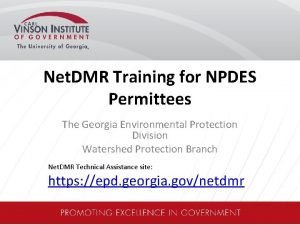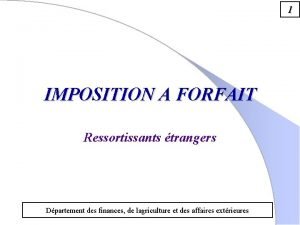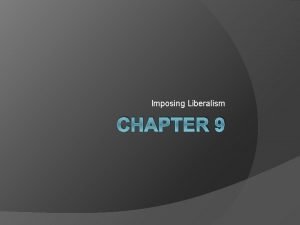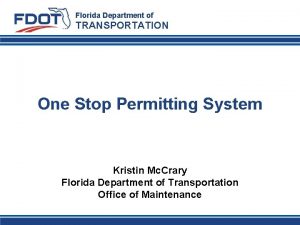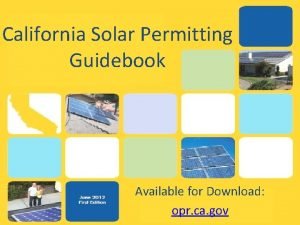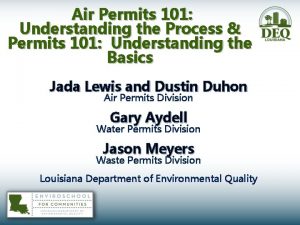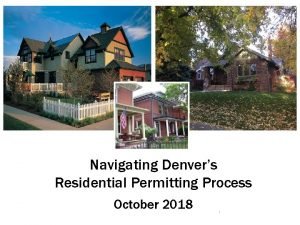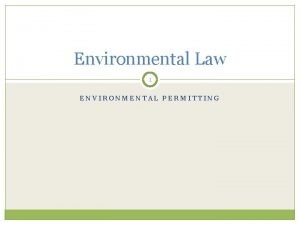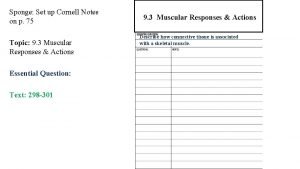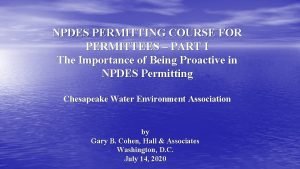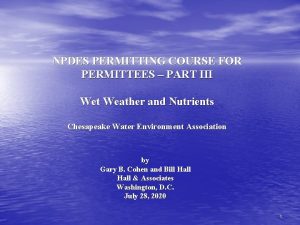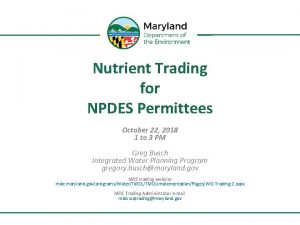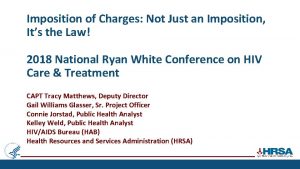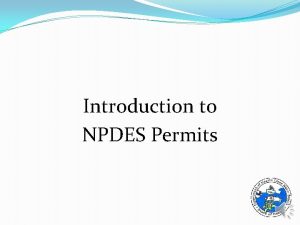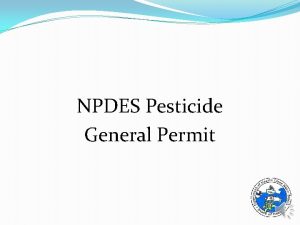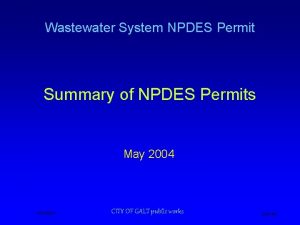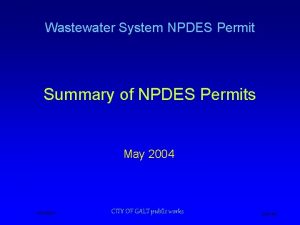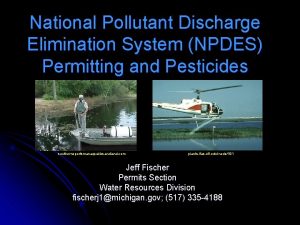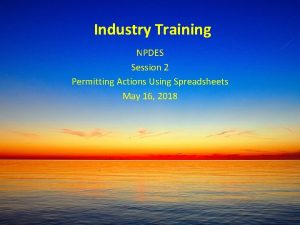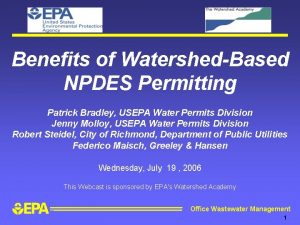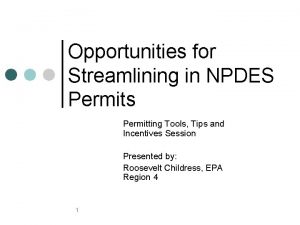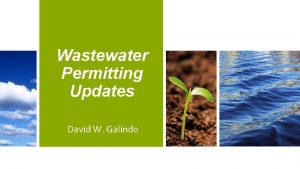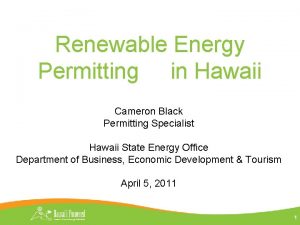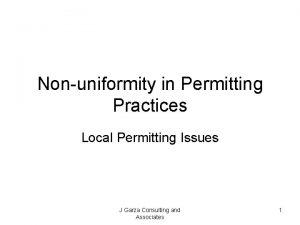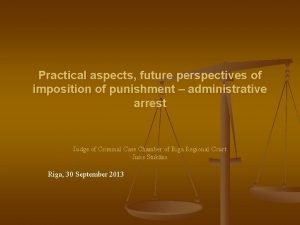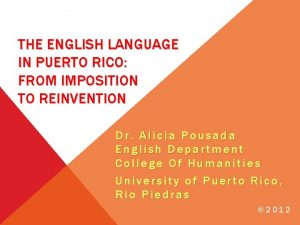NPDES PERMITTING COURSE FOR PERMITTEES PART II Imposition




































- Slides: 36

NPDES PERMITTING COURSE FOR PERMITTEES – PART II Imposition of NPDES Permit Effluent Limitations Chesapeake Water Environment Association by Gary B. Cohen and Bill Hall & Associates Washington, D. C. July 21, 2020 1

BASIS FOR PERMIT EFFLUENT LIMITATIONS LIMITATI • Usually Two-Types of Effluent-Limits - Technology-Based Effluent Limits (TBELs) - Water Quality-Based Effluent Limits (WQBELs) • BUT: - NJ: EEQ (Existing Effluent Quality) - TN: Antidegradation-Based 2

OBJECTIVES PERMITTING AGENCY PERMITTEE 1. Protection of Environment Protection of the Environment 2. Expeditious and Non-adversarial Permitting Expeditious and Nonadversarial Permitting 3. Cost of Compliance but secondary to #2 Cost of Compliance – Primary to #2. 4. Understaffed/Overworked with Limited Resources Minimize Risk of Noncompliance in a Cost-Effective Manner 3

TBELs • Effluent Limits Applicable to a Category or Class of Discharges Based Upon the Technology Available to Treat the Pollutants. • CWA Goal: Zero Discharge • Can be More or Less Stringent than the Level Necessary to Protect the Receiving Water • Some Have Described it as “Treatment for Treatment Sake. ” 4

SECONDARY TREATMENT STANDARDS FOR MUNICIPAL DISCHARGERS Parameter 30 -Day Average 7 -Day Average BOD 5/CBOD 5 30/25 mg/L 45/40 mg/L TSS 30 mg/L 45 mg/L p. H Range: 6. 0 – 9. 0 Percent Removal 85% (monthly average) for BOD 5/TSS 5

SECONDARY TREATMENT ADJUSTMENTS • Adjustment of BOD/TSS Limits Based Upon Significant Industrial Influent • Adjustment of Percent Removal Based Upon Dilute Influent • Equivalent-to-secondary limits: – Up to 45 mg/l (30 day average) – Up to 65 mg/l (7 day average) – Not less than 65% removal 6

INDUSTRIAL FACILITIES • Effluent Limitation Guidelines (ELGs) - BPT: Best Practicable Control Technology Currently Available - BCT: Best Conventional Pollutant Control Technology - BAT: Best Available Control Technology Economically Achievable - NSPS: New Source Performance Standards • Best Professional Judgment (BPJ) • Direct Discharger vs Indirect Discharger 7

POTENTIAL INCREASED STRINGENCY UNDER ELGs NSPS: New Source Performance Standards BCT: Best Conventional Pollutant Control Technology BAT: Best Available Control Technology Economically Achievable BPT: Best Practicable Control Technology Currently Available 8

TYPICAL EFFLUENT LIMITATION DEVELOPMENT Develop Technology-Based Effluent Limits for All Pollutants of Concern Will Limits Assure Compliance with Applicable Water Quality Standards? No Develop Water Quality-Based Effluent Limits Yes Include Applicable Effluent Limits in NPDES Permit 9

WHEN IS A WQBEL REQUIRED? • Reasonable Potential Test – 40 CFR § 122. 44(d) or State Standard • Limitations Must Control Pollutants or Pollutant Parameters (Either Conventional, Nonconventional, or Toxic Pollutants) That Are or May be Discharged at a Level Which Will Cause, Have the Reasonable Potential to Cause, or Contribute to an Excursion Above any State Water Quality Standard, including State Narrative Criteria for Water Quality. [§ 122. 44(d)] • Cause or Contribute is Not a Prohibition! • Permit Limit May be Numeric or Best Management Practice (BMP) 10

FACTS PREEMPT ASSUMPTIONS • Potential Concern: You Know What They Say When Someone “Assumes” • Assumptions Result in More Stringent Permit Limits than Necessary to Protect Water Quality • Who Do You Think Will Likely Be Tracking Down the Facts to Dispel Inappropriate Assumptions? Who has the Greater Interest? 11

NO WQBEL REQUIRED • No Reasonable Potential = No WQBEL. • So no Effluent Limitation Unless TBEL. • Would This be Good News to the Permittee? - In the Newly Reissued NPDES Permit? - What About Future Reissued NPDES Permits? 12

ANTIDEGRADTION EFFLUENT LIMITS? • Future Permit Providing for Increased Discharges Triggering Antidegradation • Applies to Degradation Above De Minimis Levels • If Permit Limit, Antidegradation Decision Based on Pre-Expansion Permitted Levels • BUT, if no Permit Limit, Antidegradation Based on Pre-Expansion Actual Discharge Levels 13

EXAMPLE ANTIDEGRADTION EFFLUENT LIMITS • Actual Discharge of copper at 20 mgd = 2 O ug/l. • No Reasonable Potential = No WQBEL (and no TBEL) • Calculated WQBEL for Copper Would Have Been 100 ug/l. • Seeking Facility Expansion to 30 mgd. • Would Still be no Reasonable Potential. • But Antidegradation Based Upon Loadings at 20 ug/l Plus De Minimis Increase = 14 ug/l. • Should Permittee: - Request Otherwise Unnecessary Permit Limits? - Provide Justification Based Upon Important Economic or Social Development? 14

WQBELs • Objective: Ensure Compliance with Designated Uses by Meeting Water Quality Criteria for Aquatic Life Uses, Recreation, Water Supply, Etc. • Assumption: If Water Quality Criteria are Achieved In-stream, Uses are Protected. • WQC: Magnitude, Duration, Frequency • WQBELs are Often Developed for Critical Conditions. If Objective is Achieved for Critical Conditions, it Will be Achieved for All Other Conditions. 15

PARAMETERS OF CONCERN • Metals: Copper, Zinc, Lead, Mercury • Organics: Volatiles/Non-Volatiles, PCBs, Disinfection Byproducts • Ammonia-nitrogen • Whole Effluent Toxicity (WET) • Salts: Chloride, Sulfate, Conductivity, etc. 16

WATER QUALITY-BASED EFFLUENT LIMITS • 17

WATER QUALITY-BASED EFFLUENT LIMITS • There is no right answer. The only requirement is that the WQBEL is protective. Example from 1991 TSD: Steady State – 7. 15 µg/L; Dynamic Model – 21. 4 µg/L Either result is acceptable – which do you want 18

POTENTIAL ASSUMPTIONS OF CONCERN • Default Values in WQBELs • Toxic Fraction (Metals) – Total Recoverable (Very Conservative) – Dissolved Fraction (Better, But Still Conservative) – Water Effect Ratio – Biotic Ligand Model (BLM) • Steady-State vs Drifting Organism • Probabilistic Modeling 19

WATER QUALITY CRITERION • Is it a Fixed Concentration? – Yes (e. g. , Chlorine) – Use Criteria Directly in Simple Mixing Equation – No (e. g. , Copper – Dependent upon Other Factors – p. H, Dissolved Organic Carbon, Hardness, Other Cations and Anions) – Requires Further Analysis – No (e. g. , Ammonia-nitrogen – Dependent upon p. H, Temperature, Presence of Early Life Stages, Presence of Sensitive Mussels or Salmonids) – Seasonal Analysis Required • Acute Criterion (toxicity); Chronic/Human Health (Growth, Reproduction, Health Effects) 20

CRITICAL RECEIVING WATER FLOW • Harmonic Mean – Carcinogens (Criteria Based on 70 -year Exposure) • 7 Q 10 – Most Acute and Chronic Criteria • 30 Q 10 – Ammonia-nitrogen (Chronic Criterion – 30 -day Average Concentration); Human Health Parameters • 1 Q 10 – May be Appropriate for Acute Criteria if Parameter is a Fast-Acting Toxicants (Most Toxicants are not Fast Acting) Stream Flows Change with Time. Check for Fundamental Changes due to Changes in Hydrology (Impoundments, Tile Drains) 21

SEASONAL FLOWS • What if Criteria differ during Seasons? • Example: Ammonia (Criterion is a Function of p. H, Temperature, Life Stage) • Critical Flows Can be Based Upon Seasons In other words, Permit Writer can use a Higher Winter Critical Flow to Avoid having Overly Stringent Winter Limits based upon Critical Low Flow during the Summer. 22

DILUTION FACTOR • Evaluated in Zone of Initial Dilution (ZID) and Edge of Regulatory Mixing Zone • Acute Criteria – Applied at Edge of ZID or Evaluated as Average Exposure for 1 -hour Drift – Reactive parameters (chlorine) dissipate with drift • Chronic Criteria – Applied at Edge of Regulatory Mixing Zone • Seasonal Effects? Options for Improving Dilution Factor 23

DILUTION FACTOR Options for Increasing Dilution Factor 1. 2. 3. Do a Dye Study – Confirm Actual Dilution Install a Diffuser Bring Flow to Outfall (Under Design Conditions) 24

EFFLUENT FLOW • Typically use Design Flow • Other Considerations – Wet Weather versus Dry Weather – How does Facility Flow vary with Stream Flow? • Tiered Permit Limits Based Upon Different Plant Flows – Current Flow << Design Flow • Issue With Mass-Based Limits 25

EFFLUENT FLOW Effluent flow correlated with stream flow – use effluent flow expected at 7 Q 10 26

BACKGROUND CONCENTRATION • Characterization of Background Conditions (Assimilative Capacity) • What Concentration should be Used? – Maximum – High Percentile – Average/Median Typically, an Average or Median Concentration should be used because the Calculation Methodology is already Conservative (Assume High Discharge Concentration Occurs during 7 Q 10). However, Need to Check whether Background Concentration is Correlated with Low Flow Conditions. 27

BACKGROUND CONCENTRATION Variability of Hardness with Stream Flow – Background Hardness may Increase under Drought Flow Conditions – Important for Hardnessbased Criteria. 28

OTHER CONSIDERATIONS • Steady State (magnitude) • Mass Balance Approach • Evaluation at Edge of Mixing Zone • Conservative • Drifting Organism (magnitude and duration) • Consideration of Mixing Zone Size and Travel Time • Account for Increase in Dilution with Distance • Fate of Pollutant with Time (Important for Chlorine) • Calculate Flux-Averaged Concentration over Time • Probabilistic Modeling (magnitude, duration, frequency) • Need Lots of Data • Correlations are Considered • WQBEL Based on Frequency of Exceedance (Once in Three Years, on Average) 29

CONVERSION TO PERMIT LIMITS • See EPA TSD (1991) for Statistical Methods 30

EVALUATION OF EFFLUENT DATA 31

EVALUATION OF EFFLUENT DATA CV = 0. 47; AML = 2. 99 mg/L at 99 th Percentile 32

EVALUATION OF EFFLUENT DATA Fit Data to Upper End of Distribution to Better Fit High Concentrations. CV = 0. 35; AML = 2. 51 mg/L at 99 th Percentile 33

EVALUATION OF EFFLUENT DATA Use More Recent Data based on Steady Decline. Fit Data to Upper End of Distribution to Better Fit High Concentrations. CV = 0. 32; AML = 2. 02 mg/L at 99 th Percentile 34

TOTAL MAXIMUM DAILY LOADS • Implement water quality standards for multiple pollutant sources. (Divide the pie) • Load allocations vs wasteload allocations – Wasteload allocations apply to point sources (NPDES Permittees: POTWs, industrial, stormwater discharges) – Load allocations apply to non-point sources (no regulatory authority – compliance is voluntary) – Chesapeake Bay (point source squeeze) • Limits need to be consistent with the manner in which the TMDL was developed 35

For Additional Information Gary B. Cohen Bill Hall & Associates 1629 K Street, N. W. Washington, DC 20006 (202) 463 -1166 gcohen@hall-associates. com 36
 Dmr training courses
Dmr training courses The imposition of the tax causes the quantity sold to
The imposition of the tax causes the quantity sold to Cultural imposition in nursing
Cultural imposition in nursing Convention de double imposition
Convention de double imposition Imposition des mains dd5
Imposition des mains dd5 Examples of imposing liberalism
Examples of imposing liberalism Fdot one stop permitting
Fdot one stop permitting Environmental permitting
Environmental permitting Solar permitting guidebook
Solar permitting guidebook Title v air permits 101
Title v air permits 101 Denver residential permitting guide
Denver residential permitting guide Environmental permitting regulations 2010
Environmental permitting regulations 2010 Course interne course externe
Course interne course externe Disadvantages of cavity wall
Disadvantages of cavity wall Course title and course number
Course title and course number Fast twitch and slow twitch muscles
Fast twitch and slow twitch muscles Etik och ledarskap etisk kod för chefer
Etik och ledarskap etisk kod för chefer Frgar
Frgar Jiddisch
Jiddisch Humanitr
Humanitr Datorkunskap för nybörjare
Datorkunskap för nybörjare Toppslätskivling dos
Toppslätskivling dos Ekologiskt fotavtryck
Ekologiskt fotavtryck Steg för steg rita
Steg för steg rita Redogör för vad psykologi är
Redogör för vad psykologi är Geometriska former i förskolan
Geometriska former i förskolan Bästa kameran för astrofoto
Bästa kameran för astrofoto Svenskt ramverk för digital samverkan
Svenskt ramverk för digital samverkan Rap texter som rimmar
Rap texter som rimmar Tidbok
Tidbok Fredsgudinna
Fredsgudinna Fspos vägledning för kontinuitetshantering
Fspos vägledning för kontinuitetshantering Orubbliga rättigheter
Orubbliga rättigheter Verktyg för automatisering av utbetalningar
Verktyg för automatisering av utbetalningar Ministerstyre för och nackdelar
Ministerstyre för och nackdelar Bamse för de yngsta
Bamse för de yngsta Bat mitza
Bat mitza
